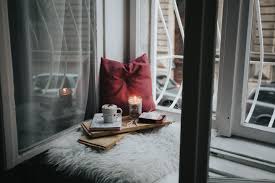I don’t actually remember the first time I came across the word “hygge.”
It was at least two years ago. Probably as a hash-tagged term on some Instagram account. Or maybe it was after my aunt did one of those ancestry DNA tests and we all found out our Gaelic heritage is tied to Scandinavia. Whatever it was that sparked my curiosity, it kept pulling the word “hygge” to mind until finally I decided to learn more.
 First stop, the library, where I checked out a quick read by Meik Wiking called “The Little Book of Hygge: Danish Secrets to Happy Living.” (He also happens to be the CEO at The Happiness Research Institute in Copenhagen and conducts studies to determine what qualities make people and places/countries “the happiest” – Denmark is frequently atop the list.)
First stop, the library, where I checked out a quick read by Meik Wiking called “The Little Book of Hygge: Danish Secrets to Happy Living.” (He also happens to be the CEO at The Happiness Research Institute in Copenhagen and conducts studies to determine what qualities make people and places/countries “the happiest” – Denmark is frequently atop the list.)
Hygge – pronounced like hoo-guh or hyuh-guh – is a concept that permeates Danish culture as much, Wiking suggests, as freedom is rooted in America’s identity.
The Danish word “hygge” has a complex etymology that stems from Old Norse (hyggja) and loosely translates to “well-being” but means something more akin to coziness, simple joys, relationships, and home comforts.
Though these days Norwegians prefer to use the word “koselig,” the concept of hygge is not limited to Denmark and Norway. Nearby countries have similar concepts (e.g., Germany has “Gemütlich”; The Netherlands uses “gezellig”) and the idea of hygge has traveled well-beyond Northern Europe. In Canada, the concept is referred to as “coziness.”
Looking back on many years growing up and living in north-central Wisconsin, I think my family truly appreciated hyggelig (“hygge-like”) living. We just didn’t call it that. Fireplaces, blankets, cabin living, mugs of hot chocolate, family movie nights, card games, cooking from scratch. These were typical of our home, especially during the cold winter months.
After reading more about hygge and coming to love the concept, I decided to take a more intentional approach to hygge living. What I’ve found is that hyggelige moments go well-beyond just warm blankets and hot chocolate.
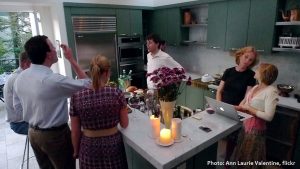
It’s a feeling, an atmosphere, an experience that embraces comfort, pleasure, and togetherness. So, to help you better understand this cultural philosophy – and in my new role as hyggespreder (you guessed it: one who spreads the hygge) – here’s a very basic look at hygge.
Atmosphere
Candles are key for hygge! Followed only by soft lighting and flickering fireplaces. To create the hyggelig atmosphere requires turning down the harsh lights and creating pockets of light in your home where people can gather for food and conversation.
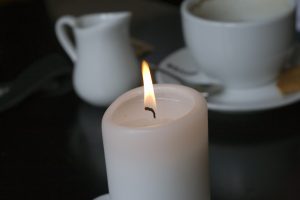
Interestingly, people in Denmark do not choose scented candles – thinking them too overpowering – and instead opt for unscented ones.
A typical Dane burns the equivalent of 13 pounds of candles each year! And it’s not just at home. Hygge and candles extend to work spaces, too.
Tip: Electric or battery-powered candles are a good alternative to real flames (especially at work in the library world!) as long as they offer that unique glow and twinkle.
It’s about fostering a comfortable space that wraps everyone in a sense of security and coziness. It might include blankets, throw pillows, and soft textures. And it also means getting together with a small group of friends is preferred over large parties and social activities. Small = cozy!
Comfort and Pleasure
Imagine this scenario: You’re comfortably dressed in your hyggebukser and hyggesokker, reading a book in your hyggekrog, all while homemade soup is simmering on the stovetop.
Okay, a few translations…
hyggebukser = that one pair of pants you’d never wear in public but secretly lounge in at home.
hyggesokker = cozy, comfy socks, often woolen.
hyggekrog = the nook in your home where you cozy up and have a hyggelige moments like a favorite chair or window seat.

Seeking moments of comfort and pleasure is another key element of hygge. It means slowing down, taking time to relax, and getting comfortable. It also means finding pleasure in the small things like reading a book, taking part in a favorite craft or hobby, baking bread, or playing music.
At work, it might be taking time for a coffee break with a colleague and enjoying cake or pastries. (I can get behind this particular hyggelig suggestion for sure!) Did you know that folks in Denmark drink 33 percent more coffee per capita than Americans? Kaffehygge!
Sounds wonderful, doesn’t it?
For many people, the most pleasurable aspects of hygge comprise good food and drink – prepared at home, often with friends or family – the longer the food takes to prepare, the more hygglig it is said to be.
Tip: Make your own gløgg (pronounced like glue-ugh). The warm drink is made with mulling spices that make your entire house smell wonderful! There are many recipes online to try and they can be adapted to make a nonalcoholic drink, too!

So, while your soup is simmering, just add a few soft blankets to your hyggekrog, enjoy a glass of gløgg, and build a fire in your fireplace (or flip the switch and turn it on, like mine) and you’ve all the makings of the most hygge setting around!
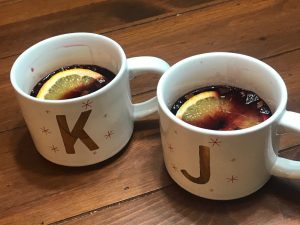
Togetherness
Spending quality time with friends, family, and even pets is central to hygge, but what sets it apart from other gatherings is the importance of being present in the moment and seeking meaningful relationships with others.
Whether its sharing a meal with family or playing a game of poker with buddies, it’s important to be in-the-now, undistracted, with everyone taking part together, equally. No one spends the evening staring at a mobile phone; no one monopolizes the conversation (or engages in political debates!). Everyone is enjoying the camaraderie!
Tip: Board games, card games, and movie nights are fun ways to spend quality time together. Plus, the slower play of a tabletop game is definitely hygge compared to flashy, fast-moving video games. And, you can check out tons of movies from the Library on DVD or via our digital apps.
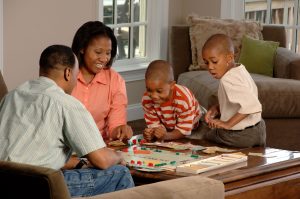
Want More Hygge?
In additional to his book on hygge, Meik Wiking also wrote “The Little Book of Lykke: Secrets of the World’s Happiest People” (lykke is pronounced loo-ka and essentially means “pursuing and finding the good that exists in the world around us every day”).
Here are a few more hyggelige books, eBooks, and cookbooks to check out.

How do you hygge?

